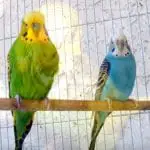One of the most exciting things that you can do with your pet parrot is to walk around with it as it remains perched on your shoulders. Although this may look easy enough to do and it even looks seamless when you spot parrots do it in movies or on TV, this is a complicated matter. Consider that not all parrots would like to interact with their owners; let alone sit on their shoulders. Also, most of the parrots you see in movies and TV are trained to perch on their caregiver’s shoulders.
This is a complicated thing but, no doubt, doable. You can teach your pet how to hop on your shoulders AND take it along with you anywhere, but you must remember the following dos and don’ts.
Dos
Do establish trust first
You can’t go far with a parrot if you don’t establish trust first. Parrots are not very trusting, and this is especially true for parrots that are new to training with you or you’re interacting for the first time. This is similar to most animals and even for humans, but parrots feel this on another level. So whatever you do, or whatever trick you want to teach your parrot, start by earning its trust.
So how do you earn your trust with a parrot who’s training with you for the first time? Start by offering treats, and whatever you do, do it slowly. Don’t rush things. Make him know that this is a simple thing, and you can be trusted.
There are many ways to earn your pet’s trust with treats. Since you need to start with handling your pet first, build a trail of treats from its cage to your hand. As your pet moves towards your hand, keep your hands open and just let it perch there as it eats.
Repeat this several times until your pet feels secure in your hand. You may now place your pet parrot on your shoulders.
Do start with the hand first
Sitting on your shoulders is not as easy as it looks for you and your pet, especially when you’re handling a large and heavy macaw or cockatoo. It will be a challenge for your pet because this is something new to him; also, it will be something new to you as well, especially if this is your first time to perform this trick as well.
So right after earning your pet’s trust, let it stay on your hand first and just transition to placing it on your shoulders when you’re certain that it is relaxed. If you overlook this, you may end up with a stressed-out bird that’s very near your face; you might get hurt.
Do train your pet slowly but surely
Slowly train your pet to sit on your shoulders. Take your time, as this is not an easy trick to do. Once your pet is relaxed on your hand, reward it with treats or offer positive reinforcement by stroking it, petting and saying supporting words.
Some pet owners say that it took them days to gain the full trust of their pet parrots and then a few more days to transition from their hand to their shoulders. And when you sense some anxiety or some kind of apprehension from your pet, cancel training and take it back to your hand where it can stay safe.
Once your pet has managed to stay on your shoulders without any worries, give it a few more days until you finally stand up and walk with it on your shoulders. Start by letting it perch on your shoulders as you sit. Then move on your seat as naturally as possible. You can eat, watch TV, read or use the computer with your pet perched on your shoulders. And once your pet is relaxed on your shoulders, it’s now time to stand and take a few slow steps. Remember to take things slowly but surely.
Do give your pet treats
Although treats are a no-no because too much can lead to obesity, it’s a vital part of training pets. Treats motivate them, but you can tweak treat giving to offering healthy treats. So instead of the usual commercially-prepared treats for birds, you can offer healthy options like dried fruits, some sweetened nuts, cooked beans, cooked pasta, or some bread. You may have known by now what your pets prefer when it comes to treats, so offer its most favorite.
Do give your pet positive reinforcement
Treats are not healthy, especially when you’re feeding your pets commercially-prepared treats. This is why experts recommend transitioning from giving your pet treats to offering positive reinforcement. You may give food treats during the initial part of the training, but soon, move to other stuff that motivates your pet like toys.
You may also say pleasant things to your pet like “good boy/girl” or “good job” just to tell him that you’re proud. Yes, parrots, like other pets, don’t understand what you mean. They simply base your reaction from your tone or your facial expression. So say these phrases as you mean it, say “WHAT A GOOOOD BOOOI!” as you mean it.
Aside from giving toys and verbal assurance, you can also hold, pet, and comfort your pet. Parrots are just like other pets; they love to be cuddled and petted as well. But it has to be coming from a person that they trust. You can pat it on the head, rub its chin or kiss it on its beak if it is used to these affectionate gestures.
Do keep your surroundings safe
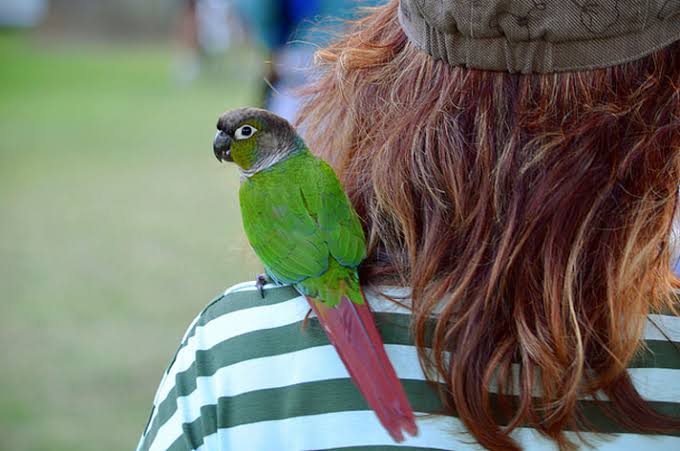
One of the most important things to consider as you train your pet to remain on your shoulder is safety. Remember that this is something new for you and your pet, so expect some potential mishaps along the way.
Start by the room or indoor area where you’re training your pet. As much as possible, stay in an indoor area so you can better control the environment. Lock the doors, close the windows, and shut anything that your pet can fly out of.
Next, shut down electric fans and ceiling fans to make the area safer. Remove any breakables, valuable items, and anything that may get ruined in case your pet panics during the exercise. You can’t let your pet on your shoulders until it is relaxed, so you must let it relax before you start inching it on your shoulders.
There will come a time when you want to teach your pet to remain on your shoulder as you walk outdoors. This is completely different from training your pet indoors because anytime, it can fly away from you. So to avoid this, use a pet harness.
A bird harness is like a dog harness as it is fastened on the bird’s body and is connected to a long leash. If your pet ever wants to fly away, it won’t because the leash and harness won’t permit it. Let your pet wear this harness as you train it on how to remain on your shoulder in an outdoor setting.
And since you can’t parrot or bird proof the outdoors, you can start training your pet first in a secure outdoor environment like your garden, a backyard or a large aviary, and slowly move to an area where there are more people like the park or the vet. Slowly introducing people will help your pet get used to distractions and thus will learn not to be anxious.
Do teach your pet parrot to be comfortable with others
Now to complicate the situation, it’s time to teach your pet how to hop on to other people’s shoulders. Again, this will take time as it needs to trust a new person. But if your pet sees that you are assisting him and you’re nearby during the exercise, it won’t hesitate to trust this new person too. But this pleasing behavior may not be for all parrots.
Some parrots become withdrawn and stressed once another person is included in the training. Starting to win its trust is a good thing, so that it will not just learn to trust the new person for the trick but also for many more tricks to come.
Just like gaining your pet’s trust early in this post, the new person has to first offer some food from the cage to his hand. Place some food on your open hand and let your pet stay inside this open hand. As always, don’t hurry, maintain a smooth yet sensitive phase, and be wary about any sign that the bird is uncomfortable.
With patience, good training practices, and reinforcement, your pet will soon be able to perch on other people’s shoulders as well. Don’t worry if your pet does not get it the first try because every bird has its own pace. The most important thing is you tried, and you’ll do your best again next time.
Do set some boundaries
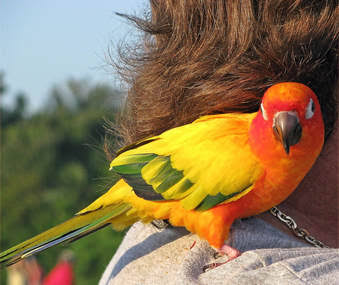
Most pet experts say that placing a parrot on your shoulder is like saying that it is above you or is higher in status than you. If this is true, then your pet is likely to do things that may be unpleasant to you, like nibbling your ear, scratching your hair and clawing your shoulder. If your parrot does this, you should learn how to set boundaries.
But it’s different when it comes to setting boundaries in parrots. To let it know that its behavior was displeasing, you should avoid reacting to it, and there are many ways to do this. You must avoid eye contact, stop communicating with your pet, and slowly remove it from your shoulder and set it on a perch. After a while, you can pick it up again and place it on your shoulder once more.
You should repeat this practice every time your pet engages in unwanted behavior. It will simply let him know that this behavior was unacceptable, and it won’t get your attention at all. Some parrots will easily get this while some can take time, so be patient.
Do train it to go down safely
A part of training your pet to perch on your shoulders is to train it to go down safely. This is very important since you have to set boundaries for bad behavior, and placing it down is one of the most efficient ways to do it.
Getting your pet to move down your shoulders also take stages and may also take time. It has to move from your shoulder to your arms to your hand and finally back to its cage or perch. First, designate the front of the cage or its perch as the area where you need to end the trick. So every time you perch it on your shoulders, you can move about and do anything you want, but when the trick ends, you have to come back to this position where it has to dismount.
When you’re in position, stay still and offer an open hand with some treats. Slowly encourage your pet to move to your hand and to remain there. Offer encouraging words and possibly its favorite toy. Repeat this practice until it readily moves as you offer an open, empty hand.
Slowly move it from your hand to its perch. Let it stay perched for a few minutes and afterward, return it to its cage.
Do recognize signs of affection
Birds like parrots are also capable of showing their affection towards their owners. A common way to do this is to rub their faces next to yours or by pressing the top of their beaks to your cheek. Parrots also show this behavior towards other parrots as well.
If you notice this behavior when your pet is perched on your shoulder, recognize it by patting, scratching its head, or simply saying some encouraging words. Be receptive to your parrot’s behavior; it’s one way to get to know your pet better.
Don’ts
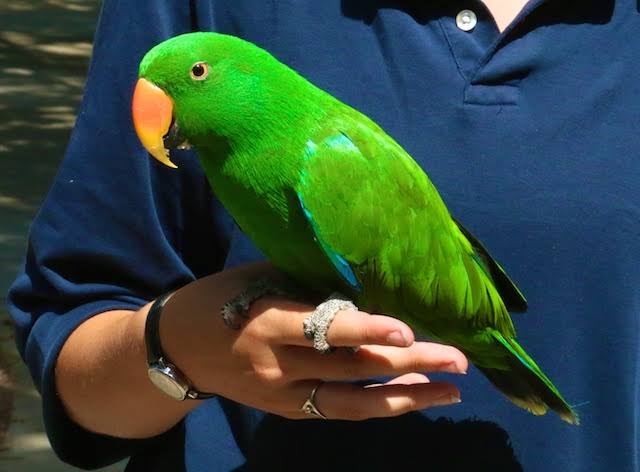
Don’t forget to bird-proof the training area
Accidents happen when performing this trick, and usually, the most common one is a fly away because you were not able to prepare the area (bird-proof) the room where you’re training your pet. Another common accident is your pet knocking down indoor décor or accidentally hurting you or other people.
So no matter what happens, secure the area where you’ll be training your pet. Don’t ever presume that everything will go smoothly because accidents may happen. To avoid these accidents, remove anything that can fall, drop, or shatter. Cover all entry and exit points and power of air conditioning and fans.
Don’t force your pet to come to you without establishing trust
A pet parrot must trust you well enough to stay on your shoulders. If you find your pet uneasy, stop the exercise and just let it come back to your hand where it can relax and eat. If you’re too in a hurry, you will only stress your pet.
Don’t forget to wear protective accessories
Even a small bird can be painful as it digs on your skin as you perform this trick what more can a parrot do. You can avoid these by wearing protective accessories. Protective equipment like long and thick gloves can help you handle your pet safely.
If you overlook this, you can get hurt as your pet’s large nails dig through your skin. If your pet is anxious and stressed from the training, you will only become more hurt.
Don’t train in a noisy area
Your pet parrot should be trained in a quiet area where there’s no noise, and disturbance can affect your training. Distractions are usually the most common reason why training fails. Birds like parrots have very good hearing, and any distraction can turn any training to failure if you overlook it. But luckily, you can always correct this by follow up training.
As much as possible, start training on how to keep a parrot on your shoulder in a quiet environment with no distractions. Only when your pet is more comfortable and relaxed that you can start working on the trick outdoors or with other people present.
Don’t move abruptly
As mentioned a while back, unnecessary movements can stress your pet and thus won’t allow you to place it on our shoulders. So if you’re walking with your pet perched on your shoulders for the first time, walk at a regular pace, not too fast and not too slow.
Don’t run and don’t move from room to room. If you must move, move without too much movement. Have all the things you need nearby so you won’t have to move a lot to get them.
Don’t overlook the daily practice
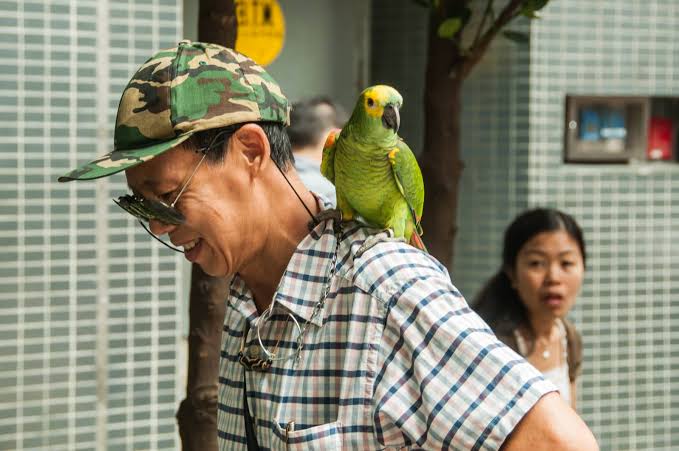
As mentioned before, this trick is not that easy, and it takes a lot of practice. You should practice daily or at any opportunity that you get, so this special trick is natural to your pet. Consider that at some point, this will not just be another trick. Placing your pet on your shoulder can be one way to move with your pet or to let it learn other tricks.
Practice indoors, outdoors, in different areas like your garden, park, or an indoor covered area. Practice with your pet alone, with people or with strangers. Practice builds confidence, and this can help your pet a lot.
Don’t forget your safety harness
Safety is very important when it comes to teaching your pet how to sit on your shoulder, especially when you’re performing this trick outdoors. As mentioned, flyaways are common, and although there’s no telling this can happen to your pet, you must always be prepared.
A good parrot harness can help you safely perform this trick and prevent flyaways. Like taking your dog out for a walk, remember to place your pet in a harness properly before you even leave the door.
Like any other trick, wearing a harness should also be done in stages. You have to let your pet wear the harness comfortably for a few days before attaching a leash. A parrot may resist wearing a harness, but don’t worry because it will soon be comfortable with it.
But never leave the harness and the leash on your pet without your supervision. Never leave the harness on while your pet is inside its cage. Never leave your home without inspecting the harness first because parrots are very tricky. Your pet can bite and eat through the harness and leash without you knowing it.
Don’t immediately approach strangers
As you move with your pet on your shoulders and walk outdoors, don’t immediately proceed outside, on the road, and meet people on the street. New people can scare your pet, and this is impossible to avoid since people will likely flock around you! So to avoid frightening your pet, start training it to be comfortable and relaxed even when there are people nearby.
First, walk around in your garden and then slowly move into an area where there are only a few people around like a park. There may be a few people trying to check you and your pet out, and when this happens, touch your pet, pat it and reassure it that this is okay. Don’t move abruptly or make sudden noises. You may also warn people to give you some space but do so in a calm way.
As you do this exercise regularly, your parrot will grow accustomed to people, even strangers, and kids.
Conclusion
A parrot on your shoulder is a wonderful trick that can create a strong bond between you and your pet. But this requires intensive training and patience. This is something new to your pet and also something new to you as well. But with daily practice, giving your pet treats and positive reinforcement, and gradually moving from an indoor to an outdoor setting, you can perfect this trick and even get a chance to show your friends and family.


